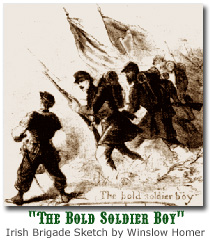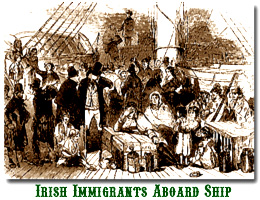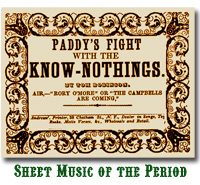"(The
Irish Brigade was) perhaps the best known of any brigade organization,
it having made an unusual reputation for dash and gallantry. The remarkable
precision of its evolutions under fire, its desperate attack on the
impregnable wall at Marye's Heights; its never failing promptness on
every field; and its long continuous service, made for it a name inseparable
from the history of the war..."
-William
F. Fox
The
Irish Experience in the Civil War
 he
Irish Brigade was not just another Civil War unit. Its military reputation
alone set it apart from the great mass of the Union Army of the Potomac.
But what made its story particularly distinctive was the Irish Catholic
identity that most of its members shared.
he
Irish Brigade was not just another Civil War unit. Its military reputation
alone set it apart from the great mass of the Union Army of the Potomac.
But what made its story particularly distinctive was the Irish Catholic
identity that most of its members shared. 
Nearly 150,000 men of Irish birth or heritage eventually fought in defense
of the Union, but most served in predominantly "American"
units where their bravery and contributions were less likely to be distinguished
from those of other ethnic groups.
The
Irish Brigade was specifically created to preserve this special identity
and to advertise the important contributions to the Union cause that
Irish Catholics made. Its founders were anxious to demonstrate to skeptical
Americans the extreme devotion that Irish immigrants felt for their
adopted land.
But
their motives were mixed, and sorting our their allegiances was not
easy. The story of Irish-American attitudes toward the issues of the
Civil War is a complex one.
Mid
19th Century Immigration
The
Irish were not the likeliest of candidates to rush to the Union war
effort. Most were recent arrivals who had not exactly been welcomed
with open arms. The terrible years of the potato famine had pushed more
than two million of the Irish overseas, with the United States becoming
their most popular destination.
 From
1846 to 1854, more than one million Irish immigrants found their way
to America. Desperate poverty caused many of these refugees to crowd
into tenements and "shanty towns" in the worst neighborhoods
of Northern cities. Willing to accept poor wages and terrible working
conditions, they soon drove blacks out of the most menial jobs available.
From
1846 to 1854, more than one million Irish immigrants found their way
to America. Desperate poverty caused many of these refugees to crowd
into tenements and "shanty towns" in the worst neighborhoods
of Northern cities. Willing to accept poor wages and terrible working
conditions, they soon drove blacks out of the most menial jobs available.
By
the 1850s, most common laborers, dock-workers, coachmen, draymen, waiters,
cooks, barbers and domestic servants in the North were Irish by birth
or heritage. Elsewhere, Irish workers dominated canal and railroad construction,
and poured into the mining industry.
Their
poverty alone might have made them outcasts, but the Catholic faith
of the Irish also subjected them to the scorn of Protestant America.
Anti-Catholicism had deep roots in the young nation's history. The earliest
English settlers of North America had been steeped in a culture that
was intolerant of Catholics.
In
the early 19th century, an organized "Protestant Crusade"
of "No-Popery" began to take shape. The antebellum era was
punctuated by fierce anti-Catholic riots, the notorious burning of a
convent, and the founding of political parties dedicated to stemming
the tide of Catholic immigration. Dread of a Papal conspiracy to undermine
America, together with economic fears of wage competition from impoverished
workers, stirred powerful emotions against the massive Irish immigration
of the potato famine years.
Political
Factors
The
1850s saw the rise of a national political movement that evolved into
a "war against the immigrant." The new American Party, whose
members became better known as the "Know-Nothings" for their
standard answer to questions about the party's secret rituals, very
nearly became the dominant force in U.S. politics by their appeals to
fear and mistrust.
Know-Nothings
attacked the Irish for their poverty, Catholicism, Democratic politics,
intemperance, criminality,  devotion
to Ireland, and attempts to sow discord between the United States and
Britain. With a political tide rising for the abolition of slavery,
the Know-Nothings eventually lost their clout, but never stopped distrusting
and discriminating against the Irish.
devotion
to Ireland, and attempts to sow discord between the United States and
Britain. With a political tide rising for the abolition of slavery,
the Know-Nothings eventually lost their clout, but never stopped distrusting
and discriminating against the Irish.
As
staunch Democrats, the Irish would have opposed any other political
party, but their ejection of the Republicans, who supplanted the Know-Nothings,
rested on an even firmer foundation. The Irish were well aware that
most of the nativists and temperance reformers who made up the American
Party had found a new political home among the Republicans. Moreover,
the Republicans had dedicated themselves to liberating blacks from slavery,
a development that would threaten the precarious foothold the Irish
had on the lower rungs of the social ladder.
Economics
of Ethnicity
An
Irish hatred of blacks stemmed largely from the intense economic competition
between the two ethnic groups in America's unskilled labor market. When
the famine Irish flooded into U.S. cities, they pushed black labor out.
African-American leader Frederick Douglass complained in 1855 that "every
house sees us elbowed out of some employment, to make room perhaps for
some newly arrived immigrants, whose hunger and color are thought to
give them special favor."
On
the contrary,
however, many employers found blacks acceptable while noting in their
advertisements for help that  "Irishmen
need not apply." Society's contempt could not have been made more
clear than it was in an ad for household servants that sought applicants
of "any country or color except Irish."
"Irishmen
need not apply." Society's contempt could not have been made more
clear than it was in an ad for household servants that sought applicants
of "any country or color except Irish."
The
anger and frustration that the Irish felt from experiencing such prejudice
was often turned against African-Americans, and observers remarked that
the Irish detested them even more than other whites who looked down
on blacks from a position of social superiority.
When
the secession crisis came, then, the Republican party could hardly expect
to gain an enthusiastic following among the Irish for its war to subdue
the South. Yet Irish-Americans in the North staunchly supported the
Union at the outbreak of war, and they answered the country's call to
arms as readily as any group in society.
Continued
>

